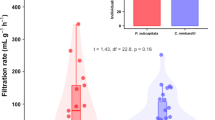Abstract
Because of the abundance and size of Oikopleura vanhoeffeni its quantitative role as a suspension feeder in cold ocean waters needs to be defined. To minimize the effect of manipulation and containment, and to assess the effect of naturally occurring factors on clearance rate, I used an in situ latex microbead technique in Logy Bay, Newfoundland, from February 1985 to June 1986. Individual clearance rates ranged from 8–944 ml h-1, increasing exponentially with increasing trunk length. Partial correlation and principal components analysis indicated that trunk length and the concentration of ingestible chlorophyll a accounted for a majority of the variation in clearance rate. At densities of 4–110 m-3, O. vanhoeffeni populations removed from >1 to 13% of the standing stock of ingestible food particles each day. Grazing by near-surface populations was lowest during the spring diatom bloom (>1.4% of daily particle production removed per day), and was highest in June during the post-bloom crash (4 to 10% of daily production removed). Some populations in mid-depth waters had much higher population clearance rates (ca. 50% of daily production removed) because of a greater proportion of large animals. The median percentage daily ration (μg Cxμg C-1xd-1x100%) of 64% accounted for observed house production rates (1 to 2 d-1, with each house=23% of body carbon).
Similar content being viewed by others
Literature cited
Alldredge, A. L. (1977). House morphology and mechanisms of feeding in the Oikopleuridae (Tunicata, Appendicularia). J. Zool. (London). 181: 175–188
Alldredge, A. L. (1981). The impact of appendicularian grazing on natural food concentrations in situ. Limnol. Oceanogr. 26: 247–257
Alldredge, A. L., Madin, L. P. (1982). Pelagic tunicates: unique herbivores in the marine plankton. Bioscience 32: 655–663
Belsley, D. A., Kuh, E., Welsch, R. E. (1980). Regression diagnostics: identifying influential data and sources of collinearity. John Wiley and Sons, New York
Chow-Fraser, P., Knoechel, R. (1985). Factors regulating in situ filtering rates of Cladocera. Can. J. Fish. aquat. Sci. 42: 567–576
Davis, C. C. (1982). A preliminary quantitative study of the zooplankton from Conception Bay, Insular Newfoundland, Canada. Int. Revue ges. Hydrobiologia 67: 713–747
Deibel, D. (1985). Blooms of the pelagic tunicate, Dolioletta gegenbauri: are they associated with Gulf Stream frontal eddies? J. mar. Res. 43: 211–236
Deibel, D. (1986). Feeding mechanism and house of the appendicularian Oikopleura vanhoeffeni. Mar. Biol. 93: 429–436
Deibel, D., Powell, C. V. L. (1987). Ultrastructure of the pharyngeal filter of the appendicularian Oikopleura vanhoeffeni: implications for particle size selection and fluid mechanics. Mar. Ecol. Prog. Ser. 35: 243–250
Deibel, D., Turner, J. T. (1985). Zooplankton feeding ecology: contents of fecal pellets of the appendicularian Oikopleura vanhoeffeni. Mar. Ecol. Prog. Ser. 27:67–78
Douglas, D. J., Deibel, D., Thompson, R. J., Griffith, P. C., Pomeroy, L. R. (1986). Cope-86: short-term temperature response of heterotrophic and photosynthetic cold ocean microplankton. Abstract. EOS, Trans. Am. Geophys. Union. 67(44): 977
Esnal, G. B., Sankarankutty, C., Castro, R. J. (1985). Diurnal and seasonal fluctuations of Oikopleura dioica Fol, 1872 (Tunicata, Appendicularia) in the mouth of the river Potengi (North Brazil). Physis (Buenos Aires), Secc. A 43 (105): 65–71
Gorsky, G. (1980). Optimisation des cultures d'appendiculaires. Approche du metabolisme de O. dioica. These Doctorate de 3° cycle. Universite de P. et M. Curie Paris VI.
Gorsky, G., Fisher, N. S., Fowler, S. W. (1984). Biogenic debris from the pelagic tunicate, Oikopleura dioica, and its role in the vertical transport of a transuranium element. Est. Coastal Shelf Sci. 18: 13–23
Hocking, R. R. (1976). The analysis and selection of variables in linear regression. Biometrics. 32: 1–49
Huntley, M. (1980). Nonselective, nonsaturated feeding by three calanid copepod species in the Labrador Sea. Limnol. Oceanogr. 26: 831–842
King, K. R., Hollibaugh, J. T., Azam, F. (1980). Predator-prey interactions between the larvacean Oikopleura dioica and bacterioplankton in enclosed water columns. Mar. Biol. 56: 49–57
Paffenhöfer, G.-A. (1975). On the biology of appendicularia of the southeastern North Sea. 10th Europ. Symp. Mar. Biol., Ostend. 2: 437–455
Parsons, T. R., Maita, Y., Lalli, C. M. (1984). A manual of chemical and biological methods for seawater analysis. Pergammon, Oxford
Pauley, K. E. (1987). Carbon uptake and turnover rates of phytoplankton in Newfoundland coastal waters. M. Sc. Thesis, Department of Biology, Memorial University of Newfoundland, St. John's Canada
Peters, R. H. (1987). The ecological implications of body size. Cambridge University Press, Cambridge
Peters, R. H., Downing, J. A. (1984). Empirical analysis of zooplankton filtering and feeding rates. Limnol. Oceanogr. 29: 763–784
Pomeroy, L. R., Deibel, D. (1986). Temperature regulation of bacterial activity during the spring bloom in Newfoundland coastal waters. Science, N.Y. 223: 359–366
Riehl, M., Deibel, D. (1987). Factors affecting the rate of house production of Oikopleura vanhoeffeni (Tunicata: Appendicularia) in coastal Newfoundland waters. Abstract. EOS, Trans. Am. Geophys. Union. 68: 1774
Steel, D. A. (1986). Feeding rates of appendicularians (Oikopleura spp.) in coastal Newfoundland waters: results of in situ studies. M.Sc. Thesis, Department of Biology, Memorial University of Newfoundland, St. John's, Canada
Thompson, R. J., Deibel, D., Pomeroy, L. R., Douglas, D. J., Griffith, P. C. (1986). Cold ocean productivity experiment (Cope-86): particle flux and seston characteristics. Abstract. EOS, Trans. Am. Geophys. Union. 67: 977
Wang, R., Conover, R. J. (1986). Dynamics of gut pigment in the copepod Temora longicornis and the determination of in situ grazing rates. Limnol. Oceanogr. 31:867–877
Author information
Authors and Affiliations
Additional information
Communicated by R. W. Doyle, Halifax
Rights and permissions
About this article
Cite this article
Deibel, D. Filter feeding by Oikopleura vanhoeffeni: grazing impact on suspended particles in cold ocean waters. Mar. Biol. 99, 177–186 (1988). https://doi.org/10.1007/BF00391979
Accepted:
Issue Date:
DOI: https://doi.org/10.1007/BF00391979




